The Art of the Cure
Using salt to preserve meat goes back to the Egyptians, but curing pork in a small New York apartment? A guide to making guanciale—including, do not plan to hang your jowls at your mother-in-law’s—with recipes for the finished product.
The ancient Egyptians were probably the first to use salt to preserve meat and fish, notes Mark Kurlansky in his epic chronicle of salinity, Salt: A World History. Masters of storage and preservation, the Egyptians also found salt to be a particularly effective aid in mummification. The Egyptians, however, were not alone among ancient civilizations in their appreciation of salt’s value in food preservation—the Chinese were pioneers, too, with the earliest record of Chinese preservation of fish in salt dating from around 2000 B.C.
Somewhere down the line, the Celts developed a specialization in curing and trading hams, and they introduced salt-cured meats to the Romans, who developed a taste for cured meats and sausages which has been passed along into modernity.
Despite technological advances in food production and preservation, cured meats remain with us today—Spanish jamon and Italian soppressata, prosciutto, and pancetta, to name just a few—though most of us have become far detached from the actual process of curing.
Over the past decade or so, there’s been a curing revival. The preparation of artisanal, “house cured” meats has become popular in professional kitchens, and it was only a matter of time before this trend would trickle down to the home cook. In his recent book, Cooking by Hand, Paul Bertolli, chef at Oliveto, in Oakland, Calif., provides one of the more comprehensive expositions on curing targeted to the home cook. An entire chapter describes, in loving detail, how to make more than a dozen different kinds of hams, sausages, and other cured delicacies—from the relatively simple two-week tesa (cured pork belly) to homemade prosciutto, which requires a 400-day marathon maturation period.
The book struck a chord. Cured meats seem to spring fully formed from a shelf behind the deli counter or appear miraculously hanging from the shop ceiling by a piece of twine. But now, I thought, I can make this myself!
I began to have visions of crafting my own cured meats. My memory raced back to a recipe for guanciale I remembered reading in Mario Batali’s The Babbo Cookbook (also online here). The Italian name for a pig’s jowl (guancia) that has been cured in salt and dried, guanciale resembles pancetta or bacon. Like saffron or truffles, guanciale is one of those fundamental ingredients for which there is considered to be no proper substitute. Were you to make a classic pasta such as bucatini alla amatriciana and replace guanciale with pancetta or bacon, you would be committing some kind of culinary heresy.
The truth was that I had never even tasted the stuff, which can be very difficult to find in the United States. Yet, with Mr. Bertolli’s written encouragement and Mr. Batali’s simple recipe, I immersed myself in a 45-day journey toward guanciale, walking down an ancient path toward my first taste of this eternal food.
Day 1: Online Cheeks Are Easy
First I had to figure out where and how to procure pig cheeks. Despite my excitement about the project, it was late winter, fiercely cold outside, and the prospect of trudging through the snow, going from butcher to butcher in search of pig cheeks, was less than appetizing. Moreover, I wanted the very best jowls for my guanciale, not just whatever I could find.
The search began and ended in roughly 10 minutes. I headed to my computer and punched in the website for Niman Ranch, the California-based purveyor of hormone-free, naturally raised and fed beef, pork, and lamb. Niman Ranch has its popular, featured selections—ground beef, beef tenderloin, flatiron steak, and thickly cut pork chops—which I bypassed for a section titled “Unique Items.” For $9 a pair plus shipping, pig jowls could be mine. I plugged in my credit card, completed my order, and waited it out. The cheeks would arrive in two days.
Nitrite Neurotic
Prague Powder II is not an X-rated movie sequel set in a Czech beauty parlor, nor is it an exclusive type of talcum powder with an East European pedigree. As it turns out, Prague Powder II is a name for curing salt (another is Instacure), a compound containing nitrites that is a common ingredient in cured meats. Nitrites have two effects on the curing process: giving the meat a vibrant, pink color and killing certain strains of botulism. Despite their positive effects, nitrites are converted in the stomach into nitrosamines, known carcinogens.
Though the Batali recipe did not indicate adding curing salt, nearly every other recipe for other cured meats that I encountered called for its inclusion. Was there something amiss in the recipe that I was using? Should I be using curing salt anyway for my own safety?
In Cooking by Hand, Paul Bertolli calls for using nitrites in his recipes for cured meats and sausages, albeit in smaller doses than mandated by federal regulations on commercially produced products. So too Alice Waters, it turns out. In her Chez Panisse Café Cookbook, Ms. Waters employs curing salt in her recipe for home-cured pancetta.
Finally, I turned to eGullet, the online culinary conclave. I was put at ease when nobody seemed to think there was an editorial error in the recipe. Moreover, a curing comrade in Tennessee logged on to claim that he had followed the same guanciale recipe on two occasions and lived to tell the tale. However, opinions still differed on nitrites in general. While I was on the one hand encouraged to do as the Romans and eschew any nitrites, others still recommended their inclusion.
Offline, eGullet member Emily Kaiser, a food writer based in Washington, D.C., put me in touch with chef Peter Pastan, who cures his own guanciale at his District of Columbia restaurant Obelisk, where he uses it to flavor slow-cooked beans and serves it sliced thin on toasted bread. In a phone call, he dismissed the idea of using nitrites out of hand. After roughly a week of worrying about whether or not to add curing salt to my guanciale, Mr. Pastan’s professional experience, total confidence, and powerful sense of culinary authority put the matter to rest for me: I decided that I would take my risks and skip the nitrites.
Day 3: Rubdown
The jowls arrived right on schedule. They were packed in a foam cooler-type box, vacuum-sealed in plastic, along with a few ice packs. Considering they had traveled nearly 3,000 miles, the cheeks were shockingly fresh-looking. Bloody and sinewy, the meat was even shaped like a pig’s profile.
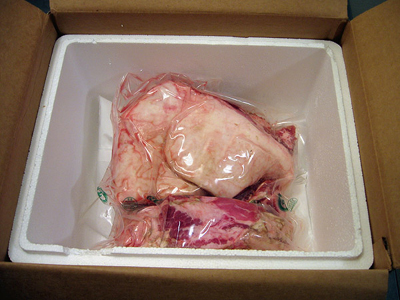
I unsealed the plastic pouch, and washed and trimmed away any parts that looked like they shouldn’t be there. I patted the cheeks dry and rubbed them all over with a mixture of thyme, peppercorns, sugar, and kosher salt.
Salt works to preserve meat in two ways: by stopping the activity and reproduction of bacteria and by shutting down the work of enzymes that encourage spoilage. Salt deactivates bacteria through the process of osmosis, whereby water is passed in and out of semi-permeable membranes. When raw meat is exposed to a high concentration of salt, the salt dissolves into the water in the meat, creating a salty solution that exerts pressure on the cell walls, disrupting the equilibrium in which the bacteria survive and feed. The outward pressure prevents the bacteria from drawing in any nutrients, and without nutrients, they are prevented from reproducing. Any spoilage that would normally take place due to bacterial growth is suspended in time. The introduction of salt also upsets the electrical balance of the liquid in which enzymes act, stopping their activity as well.
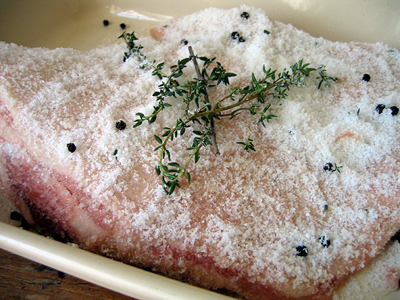
Thoroughly rubbed down, the salt immediately began to do its work on the bacteria and enzymes as the cheeks rested in the refrigerator. After just a day, the jowls began to release liquid. In a week’s time, I would need to take them from the refrigerator and hang them to dry.
Day 10: Queens Is Not Parma
The next, crucial step in curing the meat is to let it air-dry for three weeks. Cool temperatures are essential, and according to the recipe, maintaining a climate below 60 degrees Fahrenheit is a requirement. Low humidity is also necessary, not to mention cleanliness.
In Emilia-Romagna, hams being cured to make prosciutto are hung to dry in rooms with tall windows that are shut during the day to prevent exposure to warm air but opened at night to let in the cool breeze that blows from the sea over the mountains and into the Po River valley.
As the wind sweeps through the plain, it is believed to pick up the essence of orchards, wheat fields, and farms, infusing the meat with complex aromas and giving prosciutto its characteristic flavor and richness. Northeast of Italy, in the Slovenian city of Karst, the powerful Bora winds blow down from the top of the mountains into the Bay of Trieste and into attics where hams are dried to make prsut, a variation on prosciutto.
But because my wife and I are New York City apartment dwellers, coming up with an appropriate drying environment was going to be a challenge. We lack cross ventilation, and the breeze that does blow is infused with automobile exhaust, restaurant refuse, and cigarette smoke from our neighbor.
I briefly considered smuggling the jowls into the basement storage room of our Queens apartment building, tying them up inside our wire mesh storage locker. It wasn’t so airy down there, though, and I began to have visions of my cheeks infested with bugs or besieged by rats. Moreover, I couldn’t imagine the super looking fondly upon two pigs’ jowls dangling from the basement ceiling.
I asked my wife what she thought about asking her suburban-dwelling mother if I could turn her basement into a meat-curing cellar. She quickly vetoed the idea.
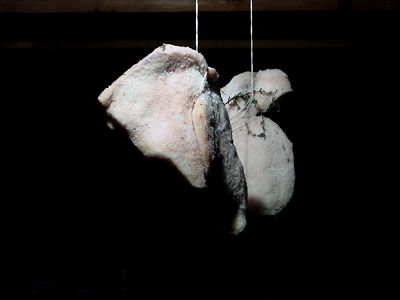
For a couple days, I considered buying a cheap wine cooler in which to dry the cheeks, but scrapped the plan when I realized that the potential for condensation might mitigate the effect of drying. Good thing: My wife wasn’t keen on this proposal, either.
Time was running out. I would need to remove the jowls from the refrigerator in the next two days, and with spring approaching, even if I found the perfect curing cellar, the temperature had the potential to rise above 60 degrees soon. I needed to move fast. I got up the courage to ask some close family friends with a house and a basement in Long Island if they would babysit my jowls while they dried out on a string in their basement. Lucky for me and my cheeks, they agreed.
After a week’s curing in the refrigerator, I removed the jowls, discarded the liquid that had been released, wrapped them in plastic, and took them out to the north shore of Long Island.
Our friends’ basement was cool and dry, scattered with some old furniture. I brought along a small fan which I had planned to use to blow a herbaceous wind on the cheeks, courtesy of some fresh rosemary, but there was no electrical outlet nearby. Luckily, there was a bank of small windows along one side of the basement that we opened to let in a crisp winter breeze. I carefully wrapped the jowls with butcher’s twine and hung them from the wooden beams lining the basement ceiling.
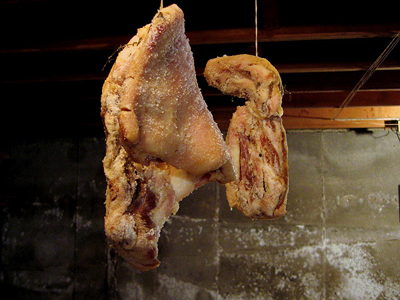
Day 45: Taste Test
We returned to Long Island five weeks later. The salt had formed a kind of crust on the outside of the cheeks. The meat itself had stiffened and dried considerably. There was no smell to it, and no sign of any spoilage. I cut off the twine, pulled the jowls down, and put them in a bag to bring home.
The final step before consuming them was to thoroughly wash all of the salt off of the surface of the meat. Still somewhat paranoid about the safety of this entire enterprise, I decided to taste the guanciale before subjecting my wife or others to any potentially deadly bacteria infestations.
I cut off a slice, mostly fat striated with thin strips of flesh. It looked like bacon. I fried it in a little olive oil until crisp, drained it, and put it in my mouth. As I bit into it, the taste was like pancetta or bacon, but perhaps with a stronger flavor of pork and a slight sweetness along with the salinity. It was much fattier than pancetta, but once it was cooked, most of the fat had rendered, leaving behind a crispy puff of porkiness.
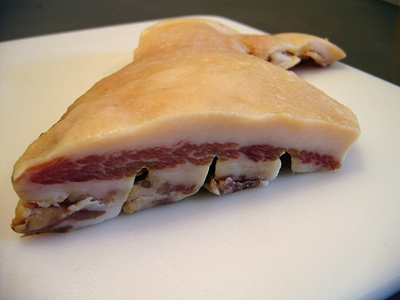
A Trio of Roman Pastas
With no major ill health effects observed after 24 hours, I launched a week of Roman meal-making, using my homemade guanciale to create three classic pastas: bucatini alla amatriciana, spaghetti alla gricia, and spaghetti alla carbonara (recipes follow below).
The first pasta I made was the bucatini all’amatriciana. Named for the town of Amatrice, southeast of Rome, the dish combines bucatini, a long, thin, tube-shaped pasta, with sautéed guanciale, tomatoes, and onions. Hot chili pepper gives the dish a piquancy, and the sauce is bound together with sharp pecorino romano. The fatty and intensely flavored guanciale, browned and caramelized in the pan, gave the simple tomato- and onion-based sauce an extraordinary depth of flavor.
After a day of rest, I moved on to spaghetti alla gricia, the tomato-less cousin of bucatini all’amatriciana. Also known as un’amatriciana in bianco (white amatriciana), it is made by sautéeing guanciale and hot chili pepper, and then tossing the crispy bits with spaghetti and grated pecorino romano. This pasta, which puts the spotlight on guanciale, was even better than the amatriciana. If you like the idea of bacon and cheese, you’ll like spaghetti alla gricia.
While guanciale may be considered mandatory in making the first two pastas, this is not the case for spaghetti alla carbonara, the legendary pasta of disputed origins. Either pancetta, bacon, or guanciale may be used to make the luscious sauce that includes eggs, pecorino romano, and black pepper. Some claim that the pasta originated during World War II, popularized by American GIs stationed in Rome who offered their war rations of bacon and powdered eggs to Italian chefs. Some maintain that the pasta’s name derives from the flecks of black pepper that resemble coal, hence “carbonara.” Others hold that spaghetti alla carbonara is named after the mountain-dwelling coalminers (the carbonari) who carried with them the main ingredients for the dish.
Whatever the actual genesis may be, pasta alla carbonara is incredibly rich and stomach-filling, made only more so by the addition of guanciale. While there is no cream in the dish, you would almost never know. When the eggs and cheese make contact with the pasta, they are transformed into a creamy sauce punctuated by the crisp little pieces of guanciale.
Postscript
Several weeks after the denouement of our Roman feast, after which we froze the remaining chunk of guanciale and called a moratorium on dining on pork fat, we got a call from the owners of our Long Island curing cellar, letting us know that they had found a pig’s jowl in the basement that had shrunk to half its size and was “covered with black spots.”
I had left behind a second jowl to experiment with a longer curing time, though it must have suffered from the balmy spring weather. I told them to throw it away. I guess I got out while the going was good with the first cheek. Lesson learned. If I ever cure guanciale again, I will do so in the late fall/early winter to allow for longer, cooler curing.
Anyone have a spare basement?
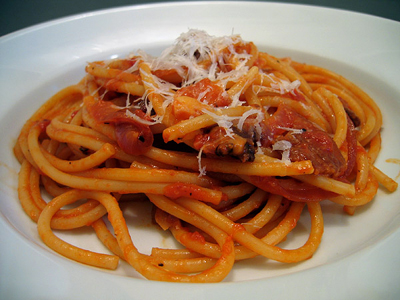
Bucatini alla Amatriciana
serves 4
Ingredients
- 2 tablespoons extra virgin olive oil
- 4 ounces guanciale
- 1 red onion, sliced
- 1/2 teaspoon hot chili flakes (or more to taste)
- 12 ounces passata (pureed Italian plum tomatoes) or 1/2 can of Italian plum tomatoes, crushed
- 1 pound bucatini or perciatelli
- 1 cup freshly grated pecorino romano
- salt and freshly ground black pepper to taste
Preparation
- Slice the guanciale 1/4-inch thick and roughly chop.
- Heat the olive oil in a large sauté pan over medium heat and sauté the guanciale until crisp. Remove the guanciale and drain, keeping two to three tablespoons of the fat in the pan.
- Raise the heat to medium-high and add the hot chili flakes and sliced onions to the pan, cooking until slightly soft.
- Add the tomatoes to the pan, season with salt and black pepper to taste, and cook over low heat.
- Drop the bucatini into salted boiling water and cook until nearly al dente.
- When the pasta is nearly done, return the guanciale to the pan with the sauce. Drain the pasta (reserving some of the cooking water) and add it to the pan with the sauce, cooking for about a minute until the pasta is al dente and some of the sauce has been absorbed. If the sauce has become too dry, add a few tablespoons of the reserved water.
- Off the heat, toss with the grated pecorino romano and serve.
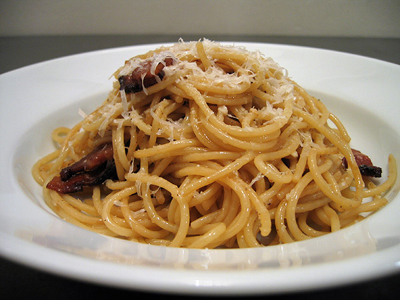
Spaghetti alla Gricia
serves 4
Ingredients
- 2 tablespoons extra virgin olive oil
- 4 ounces guanciale
- 1/2 teaspoon hot chili flakes (or more to taste)
- 1 pound spaghetti
- 1 cup freshly grated pecorino romano
- salt and freshly ground black pepper to taste
Preparation
- Slice the guanciale 1/4-inch thick and roughly chop.
- Heat the olive oil in a large sauté pan over medium heat and sauté the guanciale until crisp.
- Add the hot chili flakes to the pan and remove from heat.
- Drop the spaghetti into salted boiling water and cook until nearly al dente.
- Drain the pasta (reserving some of the cooking water) and add it to the pan with the guanciale and chili and season with salt and black pepper, cooking for about a minute until the pasta is al dente. If the pasta is too dry, add a few tablespoons of the pasta cooking water.
- Off the heat, toss with the grated pecorino romano and serve.
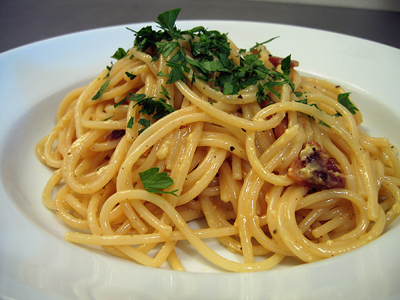
Spaghetti alla Carbonara
serves 4
Ingredients
- 2 tablespoons extra virgin olive oil
- 4 ounces guanciale
- 1 pound spaghetti
- 3 large eggs plus two egg yolks
- 1 cup freshly grated pecorino romano
- Italian parsley, chopped
- salt and freshly ground black pepper to taste
Preparation
- Slice the guanciale 1/4-inch thick and roughly chop. Heat the olive oil in a large sauté pan over medium heat and sauté the guanciale until crisp. Remove from heat and pour off all but two to three tablespoons of the fat.
- Drop the spaghetti into salted boiling water and cook until nearly al dente.
- Beat the eggs and egg yolks, mix in half of the cheese and set aside.
- Return the pan to the heat, drain the pasta (setting aside some of the cooking water), add the pasta to the sauté pan and cook for about a minute until it is al dente.
- Remove from heat, incorporate the egg and cheese mixture, and season with salt and freshly ground black pepper. The heat of the pasta will cook the eggs as they are tossed. If the sauce has become too dry, add a few tablespoons of the reserved pasta cooking water.
- Off the heat, toss with a handful of chopped parsley and the remaining grated pecorino romano and serve.
